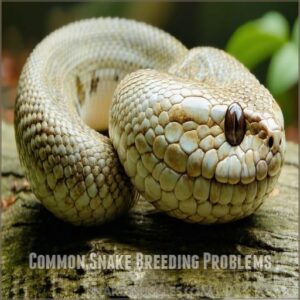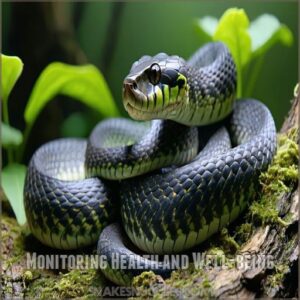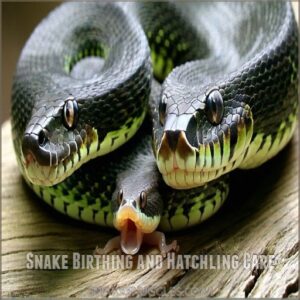This site is supported by our readers. We may earn a commission, at no cost to you, if you purchase through links.

Maintain precise temperature gradients between 75-92°F and humidity around 60%, tailoring conditions to your snake species.
Quarantine new snakes for 30-45 days, conduct thorough health screenings, and provide balanced nutrition with calcium supplements.
Watch for mating signs like male interest and female cloaca gaping.
Address potential issues such as egg binding, reproductive infections, and infertility through careful monitoring and veterinary consultation. By understanding your snakes’ unique reproductive needs and implementing rigorous care protocols, you’ll maximize your chances of breeding success.
Table Of Contents
- Key Takeaways
- Choosing Healthy Breeding Snakes
- Snake Reproductive Health Issues
- Common Snake Breeding Problems
- Environmental Control for Snake Breeding
- Nutrition and Diet for Breeding Snakes
- Snake Mating and Fertilization Issues
- Caring for Pregnant and Gravid Snakes
- Snake Birthing and Hatchling Care
- Managing Post-Breeding Complications
- Troubleshooting Common Snake Breeding
- Frequently Asked Questions (FAQs)
- How do snakes breed?
- Why is it important to manage snake breeding?
- Can a snake be bred?
- Can you breed a venomous snake?
- How can I ensure healthy snake breeding?
- What are snake breeding techniques?
- How to get rid of snakes around house foundation?
- Do snakes come back to the same place?
- Is it bad to inbreed reptiles?
- Why is my snake not eating after laying eggs?
- Conclusion
Key Takeaways
- You’ll succeed in snake breeding by meticulously controlling environmental factors like temperature (75-92°F) and humidity (around 60%), which are critical for reproductive health and successful mating.
- Selecting healthy breeding snakes requires careful assessment of body condition, genetic compatibility, temperament, and conducting thorough health screenings to prevent potential reproductive issues.
- Proper nutrition is your secret weapon—you’ll need to match prey size precisely to your snake’s body width, provide calcium and vitamin D3 supplements, and adjust feeding strategies to support optimal reproductive performance.
- Managing stress is crucial—you’ll minimize breeding complications by creating stable, quiet environments, implementing strict quarantine protocols, and monitoring your snakes’ behavioral and physiological changes throughout the breeding process.
Choosing Healthy Breeding Snakes
When choosing snakes for breeding, you’ll want to select healthy, mature specimens.
Specific criteria like age, body condition, and genetic compatibility should be considered.
Your goal is to identify docile, disease-free snakes with strong bloodlines.
This will maximize your chances of successful reproduction and produce robust offspring.
Assessing Body Condition and Age
Dive deep into snake breeding success by mastering body condition and age assessment.
Your breeding journey hinges on four critical factors:
- Precise body score charts
- Accurate age verification
- Thorough growth rate tracking
- Strategic health indicator monitoring
Weighing your potential breeding stock carefully guarantees genetic quality, prevents potential health complications, and sets the stage for robust offspring generations.
Selecting Snakes With Suitable Temperament
| Trait | Description |
|---|---|
| Calm | Minimal defensive response |
| Alert | Active but not aggressive |
| Predictable | Consistent handling behavior |
| Gentle | Relaxed during interactions |
| Stable | Low stress under handling |
When evaluating snake temperament, you’ll want to look beyond physical characteristics.
Some snakes are natural drama queens, while others are zen masters of the reptile world.
Your breeding success hinges on selecting snakes that won’t turn your careful plans into a hissing, striking nightmare of unpredictability.
Checking for Genetic Disorders
When picking breeding snakes, genetic disorders can be a snake breeder’s worst nightmare.
Your future success hinges on smart genetic screening.
Here’s what you’ll want to watch:
- Map out potential inherited diseases
- Investigate recessive gene markers
- Assess linebreeding risks
- Prioritize genetic diversity
Spotting these red flags early prevents costly breeding mishaps and keeps your snake population healthy and thriving.
Ensuring Proper Quarantine Protocols
The isolation of new snakes demands thorough attention to prevent disease transmission in your breeding program.
You’ll want to quarantine incoming reptiles for at least 30-45 days in a separate, completely isolated enclosure.
Conduct detailed parasite testing, perform disease screenings, and implement rigorous sanitation procedures to safeguard your existing snake population and maximize breeding success.
Snake Reproductive Health Issues
When breeding snakes, you’ll need to understand and address potential reproductive health issues that can impact your success.
By recognizing early signs of illness, managing stress, and maintaining proper nutrition, you’ll greatly improve your chances of a healthy breeding program.
Identifying Signs of Sickness or Injury
Throughout the journey of snake breeding, you’ll encounter critical health warning signs that can make or break your breeding success. Watch for these red flags:
- Persistent lethargy beyond normal resting periods
- Sudden appetite loss or dramatic weight changes
- Abnormal skin texture, discoloration, or unusual scaling
- Labored breathing or recurring respiratory issues
- Unexplained behavioral shifts or aggression
Managing Stress and Disease in Snakes
Spotting stress signals early can make or break your snake breeding success, and recognizing signs such as refusal to eat, escape attempts, or frequent nose rubbing (snake stress symptoms) can help you identify potential issues.
Implement rock-solid quarantine procedures to shield your slithery friends from potential diseases.
Minimize handling, maintain stable environments, and watch for behavioral changes that might indicate underlying health issues.
Regular veterinary check-ups and parasite control are your best defense against breeding mortality.
Nutrition and Diet for Reproductive Health
After managing stress becomes second nature, your snake’s diet takes center stage for reproductive health.
Pregnant snakes demand a strategic nutritional approach, balancing calcium-rich prey with precise vitamin supplements.
Carefully select prey sizes matching your snake’s body, ensuring dietary diversity that supports breeding success.
Best nutrition isn’t just a meal—it’s your breeding program’s secret weapon.
Impact of Inbreeding on Snake Health
Understanding the challenges of snake breeding demands a keen understanding of inbreeding’s genetic pitfalls.
Your reptilian breeding success hinges on avoiding genetic complications that can devastate snake populations.
Beware of the hidden risks:
- Genetic defects compromising offspring health
- Reduced fertility and reproductive potential
- Increased susceptibility to diseases and lower survival rates
Steering clear of closely related snake lineages protects your breeding program’s health and longevity.
Common Snake Breeding Problems
When breeding snakes, you’ll encounter a variety of challenging issues that can derail your success.
From egg binding and reproductive complications, to temperature and humidity control problems.
By understanding these common breeding challenges and implementing strategic solutions, you’ll increase your chances of successfully managing the complex world of snake reproduction.
Egg Binding and Other Reproductive Issues
When dystocia strikes, your female snake’s egg binding can quickly turn from a breeding hiccup to a serious health crisis.
Reproductive infections and infertility lurk as silent threats, potentially derailing your carefully planned breeding program.
Recognizing early signs of ovarian cysts or retained eggs becomes your lifeline in preventing snake breeding failure and protecting your snake’s long-term reproductive health. Early signs are key to successful breeding and snake health.
Inadequate Humidity and Temperature Control
Finding the right humidity and temperature balance is like walking a tightrope for snake breeders. Your slithery friends demand precise environmental conditions to thrive during reproduction.
Utilizing a snake heat lamp can greatly aid in creating stable thermal gradients across the enclosure.
Key challenges include:
- Creating stable thermal gradients across the enclosure
- Monitoring humidity levels to prevent respiratory complications
- Understanding species-specific temperature requirements
Your snakes’ health hinges on careful environmental control, directly impacting their reproductive success and overall well-being.
Poor Nutrition and Feeding Strategies
For snake breeders, the key to successful reproduction lies in mastering precise nutritional strategies.
Tailor your snake’s diet by carefully matching prey size to body width, ensuring proper feeding frequency and balanced nutrition.
Supplement with essential vitamins like calcium and D3 to prevent breeding-related nutritional deficiencies that could compromise reproductive health and offspring viability. This is crucial for successful reproduction. Proper nutrition is key to breeding success.
Managing Snake Aggression During Breeding
Some snake breeders might stumble when dealing with aggressive mating behaviors that can derail breeding efforts.
Managing snake aggression requires strategic intervention and careful observation:
- Identify specific aggression triggers through pre-breeding behavioral assessments
- Design enclosures that minimize stress and provide species-specific comfort zones
- Implement gradual introduction techniques that respect individual snake temperaments
Successful breeding demands patience, understanding, and nuanced conflict resolution strategies.
Environmental Control for Snake Breeding
If you’re serious about successful snake breeding, you’ll need to master the art of environmental control in your reptile habitat.
By carefully managing temperature, humidity, and light cycles, you’ll create the perfect conditions that’ll trigger your snakes’ natural reproductive instincts and improve your chances of a thriving breeding season.
Maintaining Proper Temperature and Humidity Levels
When snake breeding problems threaten your success, mastering temperature gradients becomes your secret weapon.
You’ll want to create precise heat zones that mimic natural habitats – think 75-85°F cool areas and 85-92°F warm spots.
Smart substrate choices and careful humidity control (around 60%) can make or break your breeding setup. Invest in reliable monitoring tools to track these critical environmental parameters. temperature gradients and humidity control are key.
Creating a Natural Day-Night Rhythm
Mimicking nature’s light cycles is essential for successful snake breeding.
You’ll need to replicate wild photoperiod patterns that trigger reproductive instincts.
Adjust your snake’s lighting to match seasonal changes, gradually shifting day lengths to simulate natural environmental cues.
Precise light cycle management can make or break your breeding efforts, signaling to your snakes when it’s time to get busy.
Simulating a Cooling Period for Brumation
A social media graphic depicting a highly detailed illustration of a snake enclosure showcasing a temperature gradient.
The illustration should be visually striking, using vibrant colors to clearly delineate the cool and warm zones within the enclosure.
The cool zone should be represented by a cooler color palette, perhaps blues and greens, while the warm zone should be depicted with warmer tones, like oranges and reds. The gradient should be smooth and gradual, changing seamlessly between the temperature zones.
The substrate should be highly detailed, showing texture and variation.
The overall style should be photorealistic, creating a compelling visual representation of the ideal brumation setup. The image should be devoid of any text or words.
Managing Photoperiod Cycles
Most successful snake breeders understand that light cycle impact is essential for reproductive success.
Master photoperiod management with these key strategies:
- Gradually reduce daylight hours to simulate seasonal changes
- Use artificial lighting to control breeding cycles
- Monitor light exposure carefully during brumation timing
- Adjust photoperiod to match species-specific breeding requirements
Precision in light manipulation can dramatically improve your snake breeding outcomes.
Nutrition and Diet for Breeding Snakes
You’ll want to master the art of nutrition and diet for breeding snakes to guarantee successful and healthy reproduction.
Crafting the right dietary plan involves understanding specific feeding strategies, supplements, and nutritional requirements that’ll support your snakes’ reproductive health and minimize potential breeding complications.
Dietary Requirements for Optimal Health
Nailing the right diet can make or break your snake breeding success. Your serpentine friends need a carefully balanced menu that supports their reproductive health.
For best results, consider consulting a snake breeding diet guide or shopping for nutritionally sound products at a reliable snake food store.
Check out this essential feeding guide for breeding snakes:
| Snake Size | Prey Size | Feeding Frequency |
|---|---|---|
| Small | Pinky mice | Every 7-10 days |
| Medium | Fuzzy mice | Every 10-14 days |
| Large | Adult mice | Every 14-21 days |
| Extra Large | Rats | Every 21-30 days |
| Breeding Female | Larger prey | Gradually increased |
Supplements for Breeding Snakes
Every savvy snake breeder knows calcium and vitamin D3 supplements are game-changers for reproductive health.
Essential minerals and amino acid blends can boost your snake’s breeding success, supporting peak genetic potential.
Probiotic options help maintain digestive balance, ensuring your breeding snakes stay in top condition.
Don’t skip these critical nutritional boosters.
Feeding Strategies for Successful Breeding
Because successful snake breeding starts with smart feeding, you’ll want to nail your nutritional game plan.
Match prey size precisely to your snake’s girth, typically choosing mice or rats that aren’t wider than the snake’s head.
Adjust feeding frequency based on species and individual metabolism, typically every 7-10 days.
Rotate protein sources to guarantee dietary diversity.
Avoiding Nutritional Deficiencies
With nutritional balance being key to successful snake breeding, you’ll want to dive deep into dietary supplements and prey variety.
Make certain your snakes get a balanced diet rich in calcium and vitamin D3, which are critical for reproductive health.
Carefully select prey that meets their specific nutritional needs, preventing deficiencies that could derail your breeding efforts.
Snake Mating and Fertilization Issues
If you’re serious about snake breeding, understanding mating and fertilization dynamics is essential for success.
You’ll need to master the intricacies of snake reproductive anatomy.
pheromone interactions, and the complex physiological processes that determine successful fertilization and offspring production.
Recognizing Signs of Successful Mating
After nailing your snake’s nutrition, you’ll want to spot the telltale signs of successful mating.
Watch for male interest through tongue flicking and bobbing, indicating he’s ready to tango.
When a female lifts her tail and gapes her cloaca, you’re witnessing prime snake fertilization.
Copulation might last over an hour, with sperm plugs sealing the deal – nature’s own breeding confirmation.
Managing Pheromone Trails and Mate Selection
When successful snake breeding hinges on understanding pheromone trails, you’ll want to master scent tracking strategies.
Pheromone enhancement can dramatically improve mate selection and reproductive success, especially in species where females release pheromones to initiate Passive Attraction.
Here’s how to level up your snake breeding game:
- Learn your snake’s unique chemical communication signals
- Create ideal environmental conditions for pheromone detection
- Observe and respect natural mating rituals without forcing interactions
Understanding Hemipenes and Snake Reproductive Anatomy
Ready to discover the mysterious world of snake reproductive anatomy? Hemipenes play a key role in snake mating, serving as the primary reproductive organs for male snakes. These unique paired structures enable complex reproductive strategies.
| Feature | Description | Significance |
|---|---|---|
| Hemipene Structure | Paired reproductive organs | Enables successful sperm transfer |
| Eversion Mechanism | External protrusion during mating | Facilitates genetic diversity |
| Specialized Surface | Hooks, spines, and textures | Supports sperm competition |
| Reproductive Strategy | Unique anatomical adaptation | Supports species survival |
Understanding these intricate details helps breeders manage snake reproductive challenges effectively.
Addressing Sperm Storage and Fertilization Issues
Building on your understanding of hemipenes, let’s explore the intricate world of snake sperm storage and fertilization.
Your snake’s reproductive success hinges on understanding delayed fertilization and sperm viability.
Some species can store sperm for months, while others rely on unique mechanisms like parthenogenesis.
Tracking breeding cycles and monitoring hemipene function can help overcome low fertility challenges and prevent potential reproductive diseases.
Caring for Pregnant and Gravid Snakes
When your snake becomes pregnant, you’ll need to provide specialized care that maintains her health and comfort throughout the gestation period.
You’ll want to focus on creating a good environment with carefully managed temperature, humidity, and nutrition to support both the mother and her developing offspring.
Identifying Pregnancy in Snakes
After mastering mating rituals, spotting snake pregnancy becomes your next challenge.
Experienced breeders recognize key behavioral changes like reduced activity and unusual body positioning.
Look for subtle signs: weight gain, abdominal swelling, and decreased feeding responses.
Gentle palpation can reveal egg development, while professional ultrasound imaging offers precise confirmation of your snake’s breeding cycle progress.
Dietary and Environmental Needs
A pregnant snake’s world revolves around comfort and survival during her delicate journey. Your breeding success hinges on creating the perfect sanctuary for her unique needs:
- Customize substrate to provide soft, moisture-retaining bedding
- Maintain pristine water quality with frequent clean replacements
- Adjust prey size to 15-20% larger than her standard meals
- Design an enclosure with multiple secure hiding spots
- Maintain precise temperature and humidity gradients
Monitoring Health and Well-being
When caring for pregnant snakes, monitoring their health becomes your top priority. Your watchful eye can prevent breeding mortality and catch potential issues early.
Check weight regularly using species-specific charts to maintain ideal condition.
| Health Indicator | Normal Range | Action Needed |
|---|---|---|
| Weight Gain | 10-20% | Monitor Closely |
| Parasite Screening | Negative | Genetic Testing |
| Activity Level | Consistent | Stress Reduction |
Snake breeding health hinges on proactive observation and swift intervention.
Managing Stress and Disease
As you monitor your gravid snake’s health, stress management becomes your secret weapon.
To make certain you’re not missing any key signs of pregnancy or potential health issues, keep an eye out for changes in temperature preference.
Keep her environment quiet and stable to prevent potential disease outbreaks.
Implement strict quarantine procedures for new snakes, watch for subtle signs of parasites, and consult a veterinarian at the first hint of trouble.
Your proactive approach can mean the difference between breeding success and failure.
Snake Birthing and Hatchling Care
When your snake is ready to give birth, you’ll need to be prepared for a delicate and critical process that requires careful attention and precise environmental control.
From recognizing the signs of imminent birth to managing the first important weeks of your hatchlings’ lives, understanding the nuanced care requirements will guarantee the health and survival of your new snake offspring.
Understanding the nuanced care requirements will guarantee the health and survival of your new snake offspring.
Recognizing Signs of Imminent Birth
Detect your snake’s impending birth by watching for telltale restlessness and nesting behavior.
She’ll likely show weight loss and noticeable abdominal swelling, signaling the final stages of gestation, which can vary greatly depending on the species and typically lasts anywhere from about 50 to 167 days as seen in snake breeding guide.
Look for subtle discharge near her cloaca, indicating she’s close to delivering her clutch.
These changes reveal nature’s intricate reproductive dance, preparing you for the miracle of snake birth.
Assisting With The Birthing Process
Signs of birthing in snakes can sneak up on you, so be prepared to handle dystocia management like a pro.
Your snake’s birthing success hinges on creating the right environment and knowing key intervention steps:
- Set up a secure, quiet nesting box with appropriate humidity
- Monitor for signs of egg retention or difficult positioning
- Stay calm and observe without unnecessary interference
Minimize stress and have a veterinary contact ready for potential complications.
Caring for Newborn Snakes
After successfully guiding your snake through birth, you’ll need to master hatchling care.
Feed baby snakes pre-killed pinky mice every 5-7 days, matching prey width to their head size.
To make sure you have the right equipment and supplies for best hatchling care, consider exploring online resources such as snake hatchling care products.
Watch closely for lethargy or regurgitation, which might signal overfeeding. Monitor growth carefully, adjusting meal portions as they develop.
Keep their world calm and stress-free to support healthy initial development.
Managing Humidity and Temperature for Hatchlings
When those adorable snake hatchlings emerge, you’ll want to nail their environmental setup faster than a rattler strikes.
Maintain humidity around 80-90% using a carefully selected substrate like vermiculite or perlite.
Create gentle temperature gradients between 82-88°F with reliable heat sources like ceramic emitters.
Proper ventilation prevents moisture buildup while keeping your tiny serpents comfortable and thriving.
Managing Post-Breeding Complications
After a successful breeding cycle, you’ll need to manage potential post-breeding complications that can impact your snakes’ health and reproductive success.
Understanding how to care for female snakes, monitor recovery time, and prevent potential issues will help you maintain the well-being of your breeding stock.
Guarantee best outcomes for future reproductive efforts.
Care for Female Snakes After Mating
Exhausted females need tender loving care after the intense mating marathon.
You’ll want to prioritize post-mating nutrition, offering slightly larger prey to help her recover from reproductive stress.
Monitor her closely for potential complications, ensuring a calm environment that supports healing.
Carefully manage her diet and minimize handling during this critical post-breeding period.
Recovery Time for Breeding Snakes
The delicate journey of snake breeding demands careful post-mating recovery strategies.
Your female snake needs dedicated rest after her reproductive marathon, typically requiring 6-12 months between breeding cycles.
Limit her stress by providing a quiet, comfortable habitat with stable temperatures and minimal handling. Nutritional support and gradual return to normal feeding schedules are essential for her long-term health and future breeding potential.
Preventing Post-Breeding Complications
After nurturing your female snake through breeding, you’ll want to shepherd her recovery with laser-focused care.
Minimize stress by providing a quiet, secure environment with minimal handling, as stress can lead to complications like egg binding, which can be a common issue during the snake breeding season care.
Monitor her closely for signs of exhaustion or potential reproductive complications.
Maintain ideal nutrition and supplement her diet to replenish energy reserves. Keep her habitat pristine and temperature-controlled to support her healing process. Minimize stress. Monitor her closely. Maintain ideal nutrition.
Addressing Health Issues in Newborn Snakes
Ensuring your newborn snake’s health starts with vigilant monitoring for sneaky respiratory problems and dehydration risks.
Watch for subtle signs of nutritional deficiencies or parasite infestations that can stunt growth.
Quick intervention prevents minor issues from becoming major complications.
By staying proactive and understanding common snake hatchling challenges, you’ll give your tiny serpents the best shot at thriving.
Troubleshooting Common Snake Breeding
Snake breeding hiccups can derail even the most carefully planned reptile reproduction strategy. When you’re facing breeding challenges, it’s essential to stay calm and methodical. Common obstacles can make or break your snake breeding success:
- Identify and resolve male infertility through thorough health screenings
- Monitor egg retention and potential reproductive tract complications
- Implement strict disease prevention protocols for best breeding outcomes
Reproductive problems often stem from subtle environmental or health issues that can dramatically impact fertility.
Low snake fertility rates frequently result from improper temperature control, nutritional deficiencies, or undiagnosed health conditions.
Careful observation, veterinary consultation, and detailed record-keeping become your best tools in managing snake breeding difficulties. By addressing potential breeding mortality risks proactively, you’ll increase your chances of successful reproduction and healthy offspring.
Frequently Asked Questions (FAQs)
How do snakes breed?
Picture two serpents locked in an intimate dance.
Males seek females through pheromone signals and temperature changes, initiating courtship by tongue-flicking and body positioning.
Successful mating involves careful introduction, precise environmental conditions, and species-specific reproductive rituals. This mating process is complex.
Why is it important to manage snake breeding?
Managing snake breeding guarantees you’re protecting both the snakes’ health and genetic diversity.
You’ll prevent potential health risks.
Control population growth, and maintain the well-being of your reptilian companions through careful, responsible breeding practices.
Can a snake be bred?
Surprisingly, 85% of snake species can be bred with proper care.
You’ll need to select healthy, compatible snakes.
Create the right environment, and understand their unique mating behaviors to successfully breed these fascinating reptiles. Breeding snakes requires careful attention to detail.
Can you breed a venomous snake?
You’ll need specialized expertise to breed venomous snakes safely.
It’s not for beginners!
Extreme caution, professional-grade protective equipment, and extensive herpetological training are critical.
Only experienced professionals should attempt this high-risk endeavor.
How can I ensure healthy snake breeding?
Like a gardener nurturing delicate seedlings, guarantee snake breeding success by selecting healthy specimens, creating ideal environments, monitoring temperatures, providing proper nutrition, and consulting experts for guidance throughout the process.
What are snake breeding techniques?
Master snake breeding by selecting healthy, compatible snakes, creating ideal environmental conditions, carefully introducing mates, monitoring temperatures and humidity, and providing specialized care throughout the breeding and hatching process.
How to get rid of snakes around house foundation?
Seal foundation cracks, remove debris, and trim vegetation near your house.
Use natural repellents like sulfur or commercial snake deterrents.
Keep your yard clean and free of rodents to discourage snake habitation.
Do snakes come back to the same place?
Snakes often return to familiar territories with reliable food sources, shelter, and breeding grounds.
Your property might become a recurring habitat if it offers consistent warmth, prey, and protective hiding spots.
Is it bad to inbreed reptiles?
Inbreeding in reptiles isn’t just a genetic gamble—it’s a potential disaster.
You’ll risk compromising your animals’ health.
reducing genetic diversity, and potentially creating offspring with serious developmental and immune system weaknesses.
Why is my snake not eating after laying eggs?
After laying eggs, your snake’s metabolism and energy levels are depleted.
You’ll want to give her time to recover.
Offering smaller, more frequent meals and maintaining a stress-free environment to encourage her appetite to return.
Conclusion
Addressing snake breeding problems is like dancing with delicate dragons—every step matters.
You’ve learned the secrets to successful breeding, from selecting healthy snakes to managing their complex reproductive needs.
By mastering temperature, humidity, nutrition, and health protocols, you’ll transform potential challenges into breeding triumphs.
Remember, patience and knowledge are your greatest tools. Stay vigilant, consult experts, and keep refining your approach to snake breeding problems and solutions.






















